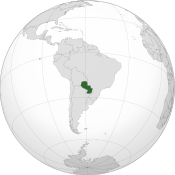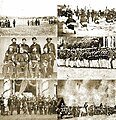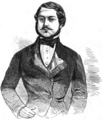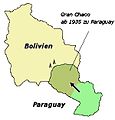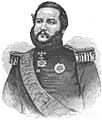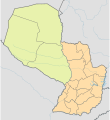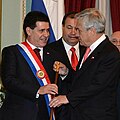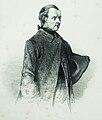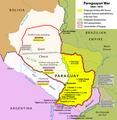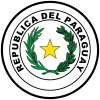Portal:Paraguay
The Paraguay Portal
Paraguay (/ˈpærəɡwaɪ/; Spanish pronunciation: [paɾaˈɣwaj] ⓘ), officially the Republic of Paraguay (Spanish: República del Paraguay; Guarani: Paraguái Tavakuairetã), is a landlocked country in South America. It is bordered by Argentina to the south and southwest, Brazil to the east and northeast, and Bolivia to the northwest. It has a population of around 6.1 million, nearly 2.3 million of whom live in the capital and largest city of Asunción, and its surrounding metro area. Spanish conquistadores arrived in 1524, and in 1537 established the city of Asunción, the first capital of the Governorate of the Río de la Plata. During the 17th century, Paraguay was the center of Jesuit missions, where the native Guaraní people were converted to Christianity and introduced to European culture. After the expulsion of the Jesuits from Spanish territories in 1767, Paraguay increasingly became a peripheral colony. Following independence from Spain in the early 19th century, Paraguay was ruled by a series of authoritarian governments. This period ended with the disastrous Paraguayan War (1864–1870), during which the country lost half its prewar population and around 25–33% of its territory. In the 20th century, Paraguay faced another major international conflict—the Chaco War (1932–1935) against Bolivia—in which Paraguay prevailed. The country came under a succession of military dictators, culminating in the 35 year regime of Alfredo Stroessner, which lasted until his overthrow in 1989 by an internal military coup. This marked the beginning of Paraguay's current democratic era. Paraguay is a developing country, ranking 105th in the Human Development Index. It is a founding member of Mercosur, the United Nations, the Organization of American States, the Non-Aligned Movement and the Lima Group. Additionally, the city of Luque, in metropolitan Asuncion, is the seat of the South American Football Confederation. Although one of only two landlocked countries in South America (Bolivia is the other), Paraguay has ports on the Paraguay and Paraná rivers that give exit to the Atlantic Ocean, through the Paraná-Paraguay Waterway. The majority of Paraguay's 6 million people are mestizo, and Guarani culture remains widely influential; more than 90% of the population speak various dialects of the Guarani language alongside Spanish. Paraguay's GDP per capita PPP is the seventh in South America. In a 2017 Positive Experience Index based on global polling data, Paraguay ranked as the "world's happiest place". (Full article...) Selected article - The Revolt of the Comuneros (Spanish: Revolución Comunera) was a series of uprisings by settlers in Paraguay in the Viceroyalty of Peru against the Spanish authorities from 1721 to 1725 and 1730–1735. The underlying cause of the unrest was strong anti-Jesuit feelings among the Paraguayans and dislike for any governor seen as favoring the Jesuits. In the resumption of the revolt in 1730, economic issues came to fore as well. The rebel organization split in its second phase, as the rural poor and the urban elite each formed their own factions with similar grievances against the Jesuits, but incompatible politics. Paraguay had an unusually strong tradition of self-rule; the colonists did not have a tradition of strict obedience to everything the Spanish Crown's governor decreed. This independence helped push the revolt forward. The beginnings of the revolt were quasi-legal at first. José de Antequera y Castro (1690–1731), a judge for the Real Audiencia of Charcas, was sent to Asunción in 1721 to examine charges of misconduct against pro-Jesuit Governor Diego de los Reyes Balmaseda. Antequera concluded the charges were valid, forced Reyes into exile and later imprisoned him, and declared himself governor by the power of the Audencia in 1722. Antequera also accused the Jesuits of various crimes, demanded that the mission Indians under their care be enslaved and distributed to the citizens of Paraguay, and expelled the Jesuits from their college in Asunción. All these actions had the support of the citizens of Asunción, and governors had been deposed and replaced before without the central government complaining. However, Viceroy of Peru Diego Morcillo, residing in Lima, did not approve of Antequera's action and ordered Reyes' restoration as governor. With the backing of the settlers, Antequera refused, citing the authority of the Audencia as superior to that of the Viceroy. The feud between Antequera and the Viceroyalty continued after Viceroy Morcillo was replaced by the Marquis of Castelfuerte as Viceroy of Peru. Antequera's Paraguayan militia attacked and defeated an allied force of Jesuit mission Indians and Spanish colonial forces during the standoff. The battle tainted the legitimacy of Antequera's claim of governorship, however, and a second force was sent by Castelfuerte against a movement now seen as clearly treasonous. Antequera resigned in 1725 and fled to Charcas, while order was seemingly restored in the province. Antequera was arrested, imprisoned for five years at Lima, and executed. (Full article...)CategoriesGeneral imagesThe following are images from various Paraguay-related articles on Wikipedia.
Did you know?WikiProjectsThings to doRelated portalsWikimediaThe following Wikimedia Foundation sister projects provide more on this subject:
| ||||



